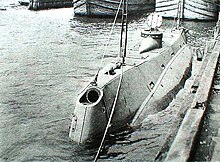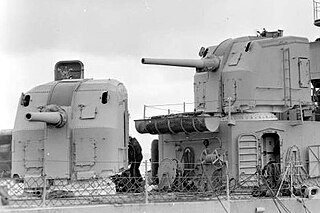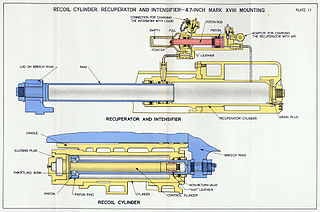History
The Zalinski dynamite gun

The original invention of a gun to fire an explosive charge with compressed air was the work of D. M. Medford of Chicago, Illinois. His prototype was demonstrated in 1883 at Fort Hamilton, New York. Edmund Zalinski, an American artillery officer, saw the demonstration, and over the next few years improved the design, building and demonstrating a series of prototypes. Some of his work took place at Fort Lafayette, New York. [1]
The Navy was impressed, and commissioned the construction of a specialized "dynamite gun cruiser." The USS Vesuvius, launched in 1888, was armed with three fifteen-inch pneumatic guns capable of firing an explosive projectile 1.5 miles (2.4 km), and eventually bombarded Cuba in the Spanish–American War. The projectiles were sometimes called "aerial torpedoes".
In 1897, an 8.4-inch (210 mm) Zalinski dynamite gun was fitted to the first commissioned US submarine USS Holland (SS-1). It was later removed in 1900.

From 1894 to 1901, the Army purchased and installed several coastal artillery batteries of 15 inch (381 mm) dynamite guns as part of the coast defense modernization program initiated by the Endicott Board. These could throw an explosive projectile from 2,000 to 5,000 yards (1,800 to 4,600 m) depending on the weight of the projectile, from 500 to 50 pounds (227 to 23 kg). Compressed air at 2,500 psi (17 MPa) was supplied by a steam-driven compressor. In addition to the guns and their ammunition, the steam boiler, compressor, and other equipment necessary to operate the guns weighed over 200 tons. Among other locations, three guns were installed as Battery Dynamite at Fort Winfield Scott, near the Presidio of San Francisco. In 1904 the batteries were decommissioned, and the guns dismounted and scrapped. A bolt circle for a 15-inch dynamite gun remains near the southwest tip of Fisher's Island, New York on the former site of Fort H. G. Wright.

The Sims-Dudley dynamite gun

Pneumatic guns for shipboard use, or at fixed coastal fortifications, could rely on a steam-driven gas compressor as an air source. For use by troops in the field, this was impractical. The Dudley-Sims dynamite gun used a smokeless powder charge to compress the air. Beneath the gun barrel was a cylinder into which the powder charge was loaded. When fired, the expanding gas from the smokeless powder compressed the air in the cylinder, which was then fed into the gun barrel, accelerating the explosive projectile. The US Army bought sixteen of these guns.
The Sims-Dudley gun weighed about one thousand pounds and had a bore diameter of 2.5 inches (6.4 cm). Its ammunition was not actually dynamite; the shells were filled with a nitrocellulose-based gelatin, and exploded by either a time or percussion fuze. Each round of ammunition weighed about 10 pounds (4.5 kg), 5 pounds (2.3 kg) of which was the explosive filler. It was cylindrical in shape, with a rounded nose, with twisted vanes on its back to provide spin-stabilization during flight.
Roosevelt and his Rough Riders used a Sims-Dudley gun during the siege of Santiago, with mixed results. The gun did work as intended, delivering high-explosive shells on target. Because of its relatively quiet pneumatic operation and smokeless powder charges, it did not betray its presence, and so was not targeted by the Spanish. But it was mechanically unreliable and not very accurate. On balance Roosevelt was not enthusiastic, but found it "more effective than the regular artillery." [2]













